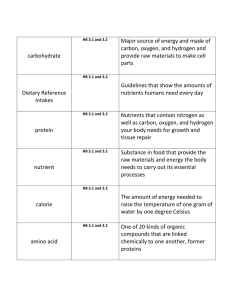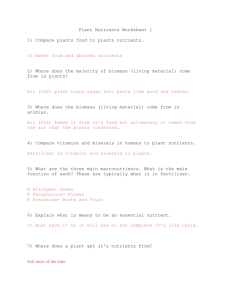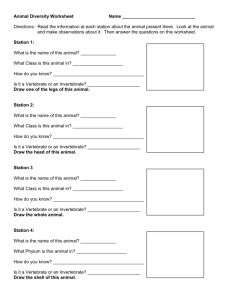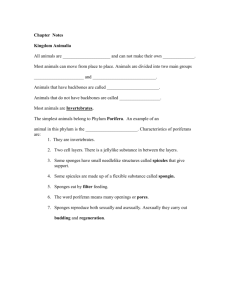Identifying and Classifying Game Animals
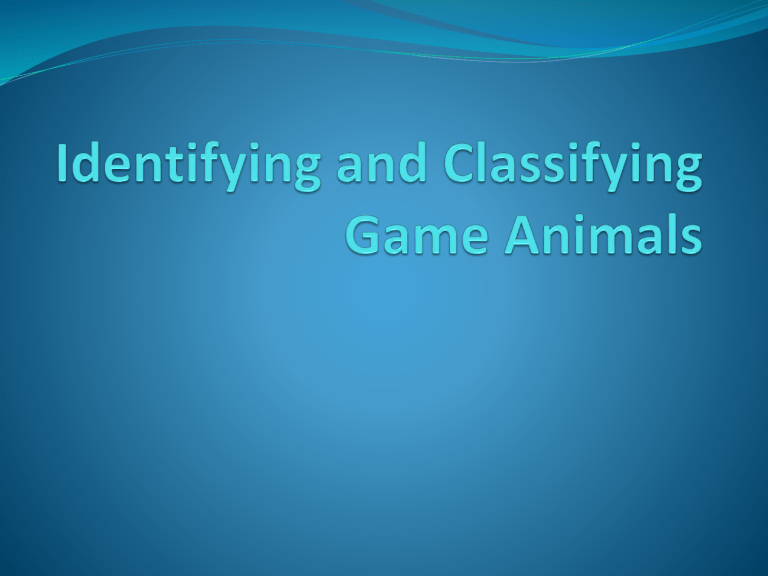
What is scientific classification?
Scientific classification is a system used worldwide that uses seven stages or levels to show relationships between organisms.
Levels of Classification
Kingdom is the broadest level. It has five divisions: animalia, plantae, fungi, protista, and monera.
Phylum is the next level. There are 14 phyla in the animal kingdom. Some important phyla when discussing wildlife are: chordata phylum (deer, fish, snakes, etc.), arthropoda phylum (ticks, insects, crawfish, etc.), and mollusca phylum (snails, oysters, clams, etc.).
Class is the third level. Mammalia, Reptilia, and Aves are examples of classes within the chordata phylum.
Each class is further broken into orders, which are based on feeding characteristics. For example, wolves and foxes are in the Carnivore order of the Mammalia class.
Common Names
Most people call animals by their common names.
However, to ensure that they are talking about the exact same animal, scientists use scientific names.
A common name for an organism is how most people know animals. (Example: GrayWolf)
A scientific name for an organism is a combination of its genus and species. (Example: Canis lupus) Canis is the genus, and lupus is the species.
Levels of Classification
Organisms that are more alike are grouped into a family.
Family classification is often based on anatomical features.
For example, wolves and foxes both have long noses and bushy tails. They both belong to the Canidae family.
Next is the genus. A genus is composed of very similar groups of organisms. However, they do not naturally breed with each other.
A species contains very similar organism. Organisms within the same species breed with each other. A species can be further broken into subspecies or breeds.
What are the differences between vertebrates and invertebrate animals?
A common way of classifying animals is based on morphology. Morphology is based on internal and external body structures. Animals can be classified into vertebrates or invertebrates.
A vertebrate is an animal with a backbone. Other characteristics include two pairs of appendages (legs and/or arms), a three-segmented body (head, neck, and trunk), and a brain at one end of the spinal cord. Some vertebrates have a tail at some point of their life.
Invertebrates are animals that do not have a backbone.
They often have an exoskeleton (an external hard body covering), which protects their internal organs and also their body.
Types of vertebrate animals
Mammals are animals that are covered with fur or
hair. They regulate their internal body temperature.
Their heart has four chambers. Additionally, the females produce milk for the babies. Mammals can further be classified based on their digestive system.
Monogastric animals have a single compartment stomach
Ruminant animals have a four-compartment stomach.
Types of vertebrate animals
Fish have an exterior covering of scales or skin.
They have paired fins, and get oxygen from water through their gills. They adjust their body temperature to the surrounding water. Some fish lay infertile eggs, which are later fertilized by the male. Others give birth to live young.
Types of vertebrate animals
Birds are covered with feathers. They have two
sets of appendages. One set is used for flying
(wings) the other for walking or swimming (legs).
They lay fertile eggs.
Types of vertebrate animals
Reptiles have a dry skin covered with scales. With the exception of snakes, reptiles have two sets of legs and five clawed toes on each leg. Reptiles lay thick walled fertile eggs.
Amphibians are animals that live in the water and on land. Their skin secretes mucus. They have two sets of appendages. They reproduce either in the water, or very moist soil. The young go through a metamorphosis as they mature.
Types of invertebrate animals
Insects have an exoskeleton, six legs, and most can fly.
They lay fertile eggs, and the young go through a metamorphosis as they mature.
Crustaceans have a very strong exoskeleton, which is shed as they grow. They have four pairs of appendages, and two pairs of antennae on their heads.
Types of invertebrate animals
Mollusks are small, soft bodied animals without
an internal skeleton. They can be further divided into bivalves (have a two part shell, like a clam) or
gastropods (single part shells, like a snail). They are usually found in salt water, but can also be found in freshwater or on land.
Types of invertebrate animals
Worms have soft bodies, no legs, and no antennae.
Worms can be further broken into groups of segmented worms, flatworms, and roundworms.
Segmented worms include earthworms and leeches.
Flatworms include flukes and tapeworms.
Roundworms include nematodes and pinworms.
Types of invertebrate animals
Spiders, ticks, mites, and scorpions are arachnids.
They four pairs of legs for walking and two pairs of legs near their heads.
What are the essential nutrients needed by animals?
Essential nutrients are needed by animals to sustain life. The nutrient requirements vary during the life cycle of the animal. Mature animals need nutrients to provide for their activity, maintenance of their body, and reproduction. Additionally, lactating females have increased need for nutrients. Nutrients can be divided into energy nutrients, proteins, minerals, vitamins, and water.
What are the essential nutrients needed by animals?
Energy nutrients are carbohydrates and fats.
Energy is needed for the animal to maintain its body and to provide for its activities. Sugars, starches, and oils provide energy nutrients.
Proteins are needed for animal growth, maintenance, and reproduction. More protein is needed during periods of active growth and during lactation. Some animals (such as carnivores) get protein from eating other animals. Plant eating animals can get protein from eating seeds and young, tender vegetation.
What are the essential nutrients needed by animals?
Minerals are needed for growth, reproduction,
and other life functions. They are very important for bones, hooves, teeth, horns, and other similar body parts. Minerals are available in the food and water that animals consume.
D. Vitamins regulate body processes and can be
found in the foods animals eat. Vitamins A, D, E,
K, and B complex are important for animal health.
What are the essential nutrients needed by animals?
Water is a nutrient that is very important for
animal health. Animal consumption of water varies by species and location. As much as 40 percent of an animals body is water. A good source of clean, nonpolluted water is essential for animal health.
What are animal food sources that come from plants?
Leaves are the green, vegetative part of the plant.
Ruminant animals, such as deer and bison, utilize them extensively.
Flowers provide nectar for insects, such as bees and
butterflies. Other animals and insects also eat flowers.
Fruit contains seeds and other edible parts. Fruit
grows on plants after it has flowered. Berries are one example of fruit.
Nuts grow on trees and contain the seed from the trees.
Nuts usually have a hard outer shell. Acorns and pecans are examples of nuts.
What are animal food sources that come from plants?
Some plants produce seeds that are not part of fruit or nuts. Seed from these plants are in pods.
Some animals and insects utilize twigs and bark.
Insects burrow into the bark of some trees and sometimes deer will eat the bark and twigs off trees.
Rodents and some animals eat the roots of plants.
Roots are the underground portion of the plant.
Nematodes, small worms, also eat roots.
What environmental factors can affect the food supply for animals?
Drought is a prolonged period without enough
rain. Mild droughts can cause a decrease in production of plant material. In severe cases, large amounts of plant material can be killed, thus drastically affecting the food supply for wildlife.
Storms can remove vegetation, fruits, nuts, and seeds from plants. Severe storms, such as tornados and hurricanes can blow down trees and other plant life.
Ice storms can cause severe plant damage.
What environmental factors can affect the food supply for animals?
Floods can smother plant life and kill it by preventing respiration and photosynthesis.
Untimely freezes can kill vegetation prematurely, or cause early season fruits to drop to the ground.
Pest outbreaks can severely affect the food production of some plant species. These can include insects and diseases. In some cases, insects and diseases can destroy whole plant communities.
What environmental factors can affect the food supply for animals?
Each year, thousands of acres of forest are destroyed by fire. Sometimes these fires are caused naturally by lightening, while other fires are caused by human carelessness.
What can humans do to supplement the natural food supply?
A. Leaving strips of untilled land around the edges of fields. These strips can provide both food and cover for wildlife.
B. Planting food producing trees, shrubs, and other plants.
C. When harvesting trees out of a forest, leaving food producing trees.
D. Providing corn and other feeds to wildlife.

